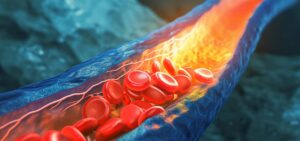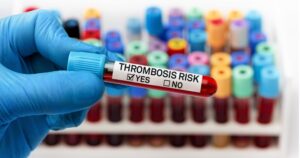Heparin‐Induced Thrombocytopenia and Thrombosis (HIT or HITT)

While the medical malpractice attorneys at MANEY | GORDON Trial Lawyers are expertly qualified to evaluate every type of medical condition and prosecute every type of medical error, we have been sufficiently fortunate to have achieved recovery for our clients in certain particularly complex areas of medicine and medical injury. One such area involves amputation (the loss of limb(s)) and death from vascular (veins and arteries) blood clotting resulting from medical malpractice. In recent years, MANEY | GORDON Trial Lawyers has become sought-after medical-legal experts in cases of heparin‐induced thrombocytopenia or thrombocytopenic thrombosis (HIT or HITT).
This is a potentially devastating immune-mediated adverse drug reaction caused by the emergence of antibodies that activate platelets in the presence of heparin.
Heparin is a blood anticoagulant that increases the activity of antithrombin. It is used in the treatment of heart attacks and unstable angina. Heparin is an anticoagulant medication that is used every day in every hospital in the United States and is administered by IV (intravenously) or by injection under the skin. It is used to decrease the clotting ability of the blood and to help prevent harmful clots from forming in blood vessels. Heparin is commonly called a “blood thinner”, although it does not actually thin the blood.
In cases of heparin‐induced thrombocytopenia and thrombosis (HIT or HITT), the medication causes the exact opposite effect for which it is designed. Rather than prevent blood from clotting, the administration of heparin actually causes the formation of significant and harmful blood clots!
The proper medical standard of care requires doctors, nurses, and medical professionals to timely appreciate this adverse reaction (heparin‐induced thrombocytopenia (HIT)) before it is too late. Proper and timely recognition of the condition enables clinically effective intervention. Unfortunately, many medical professionals fail to appreciate the complication and fail to intervene before the patient dies or requires amputation.
A blood clot is essentially an accumulation of blood that clumps together in the patient’s vessels or vascular system (veins or arteries). While heparin is administered to prevent clots, every so often, heparin can sometimes trigger a reaction that causes the blood to clot excessively instead of preventing clots. It causes the patient’s immune system to make antibodies that activate platelets. Platelets are blood cells that cause your blood to clot. In the presence of heparin, excessive blood clotting puts the patient at risk of developing life-threatening blood clots (thrombosis). The reaction also causes platelet levels to drop (thrombocytopenia).
HIT is a complication that may cause a patient to suffer from reduced platelets and excess clotting. The reaction is also called heparin-induced thrombocytopenia and thrombosis (HITT) and is the condition of having harmfully too few platelets and developing dangerous blood clots.
There are two types of heparin-induced thrombocytopenia, HIT I and HIT II. It is the latter, HIT II, that is considered a severe medical complication that requires immediate treatment.
HIT I is when the platelet levels drop within the first few days of taking heparin but then return to normal. This type of HIT does not put the patient at serious risk of blood clots and does not require treatment.
The other type, HIT II, occurs when the body’s immune system activates the platelets in response to heparin. This reaction causes the platelet levels to drop and puts the patient at risk of developing serious blood clots.
Anyone taking heparin can potentially develop HIT, regardless of dose or frequency. The condition is more common in women who are 40 years or older. To date, there is no scientific explanation as to why some people and patients react in this manner to heparin while other people and patients don’t.
Heparin-induced thrombocytopenia is fairly common from a medical statistical standard: approximately 5% of people who take heparin for more than four days develop HIT. This means that one (1) out of every twenty (20) patients administered heparin for more than 96 hours may suffer this adverse reaction or “allergy” to heparin.
Low levels of platelets may be an indication of HIT. About half of people with HIT develop a new blood clot, such as a deep vein thrombosis (DVT) or pulmonary embolism (PE).
Symptoms may include:
- Pain, swelling, redness, or tenderness in the arm or leg.
- Sudden sharp pain in the chest (like a heart attack).
- High blood pressure (hypertension).
- Feeling faint, dizzy, or light-headed.
- Rapid heartbeat (tachycardia).
- Coughing and wheezing.
- Feeling out of breath.
- Excessive sweating.
- Fever and chills.
The patient may also notice pain, soreness, or a rash at the injection site where the heparin was administered.
Early-onset HIT appears one to three days after the patient starts taking heparin. This early form of HIT occurs when the patient has taken heparin in the past (usually within the last three months). When this happens, the body “remembers” heparin because it has already physiologically been exposed to it. The patient has essentially already created antibodies to heparin that are ready to react.
Refractory or “persistent” HIT appears and then continues in the patient even weeks after heparin has been discontinued.
Delayed onset HIT doesn’t appear until the patient has stopped taking heparin. It starts five or more days after heparin cessation.
In patients with an intermediate or high pretest probability of HIT, an enzyme-linked immunosorbent assay (ELISA) to detect heparin-platelet factor 4 (PF4) immunoglobulin G (IgG) antibodies is the first diagnostic step. This is commonly called the HIT 4 T’s score.
Medical professionals possess a duty to recognize the 4 T’s of heparin-induced thrombocytopenia. The “4 T’s” (Thrombocytopenia, Timing of platelet count fall, Thrombosis or other sequelae, and other causes for thrombocytopenia) enable the calculation of a pretest clinical score for the diagnosis of heparin-induced thrombocytopenia.
When you are hospitalized for any reason, please be aware of this potential adverse reaction to heparin.
And feel free to contact us at MANEY | GORDON Trial Lawyers should you suspect that a patient has died, or suffered amputation, or lost portions of a limb because this condition was not properly and timely recognized by hospital, medical, or nursing staff.
Contact MANEY | GORDON Trial Lawyers Today for a Heparin‐Induced Thrombocytopenia and Thrombosis Case Evaluation to determine if you qualify to file a heparin lawsuit.





You must be logged in to post a comment.